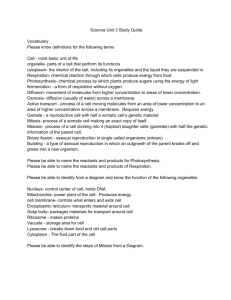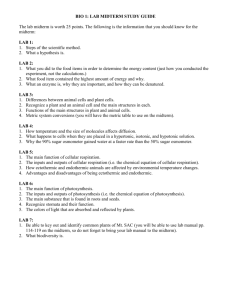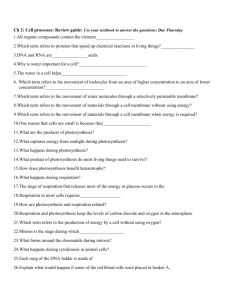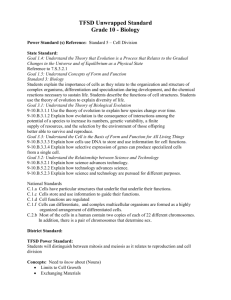CP1 Biology Midterm Study Guide 2011
advertisement
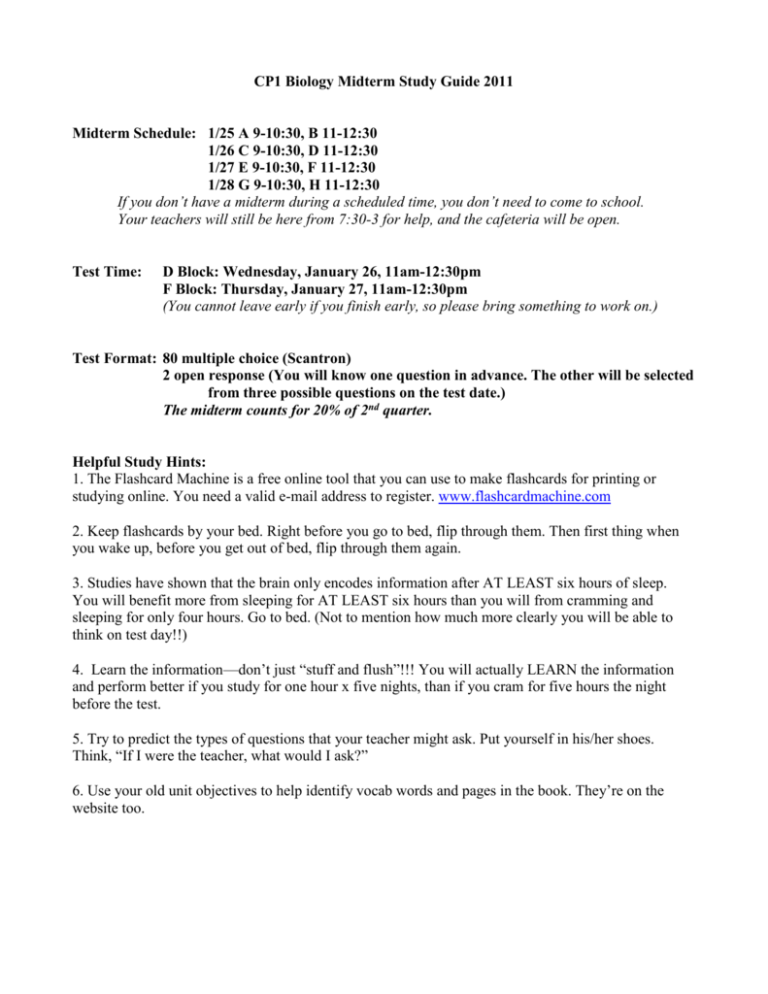
CP1 Biology Midterm Study Guide 2011 Midterm Schedule: 1/25 A 9-10:30, B 11-12:30 1/26 C 9-10:30, D 11-12:30 1/27 E 9-10:30, F 11-12:30 1/28 G 9-10:30, H 11-12:30 If you don’t have a midterm during a scheduled time, you don’t need to come to school. Your teachers will still be here from 7:30-3 for help, and the cafeteria will be open. Test Time: D Block: Wednesday, January 26, 11am-12:30pm F Block: Thursday, January 27, 11am-12:30pm (You cannot leave early if you finish early, so please bring something to work on.) Test Format: 80 multiple choice (Scantron) 2 open response (You will know one question in advance. The other will be selected from three possible questions on the test date.) The midterm counts for 20% of 2nd quarter. Helpful Study Hints: 1. The Flashcard Machine is a free online tool that you can use to make flashcards for printing or studying online. You need a valid e-mail address to register. www.flashcardmachine.com 2. Keep flashcards by your bed. Right before you go to bed, flip through them. Then first thing when you wake up, before you get out of bed, flip through them again. 3. Studies have shown that the brain only encodes information after AT LEAST six hours of sleep. You will benefit more from sleeping for AT LEAST six hours than you will from cramming and sleeping for only four hours. Go to bed. (Not to mention how much more clearly you will be able to think on test day!!) 4. Learn the information—don’t just “stuff and flush”!!! You will actually LEARN the information and perform better if you study for one hour x five nights, than if you cram for five hours the night before the test. 5. Try to predict the types of questions that your teacher might ask. Put yourself in his/her shoes. Think, “If I were the teacher, what would I ask?” 6. Use your old unit objectives to help identify vocab words and pages in the book. They’re on the website too. Open Response: You WILL answer question #1. The second open response will be chosen from #2-4 and will be announced on the day of the test. *1. Compare and contrast the four types of organic macromolecules. You should include: a. The general chemical structure b. The building blocks (if any) c. Provide examples d. Explain where the examples can be found in the environment/your body 2. Describe the relationship between photosynthesis and respiration. Be sure to describe: a. The location b. The reactants c. The majors steps involved d. The products 3. Compare and contrast active transport, facilitated diffusion, and osmosis. Be sure to describe each process in detail. 4. Describe the three major types of symbiotic relationships that could exist between the members of an ecosystem. Be sure to define symbiosis and provide an example for each type of symbiosis. Ecology – 10% of multiple choice 1. What are the characteristics of living things? What is homeostasis? 2. What is biology? 3. Identify trophic levels in a food web. 4. What are autotrophs, chemoautotrophs, and heterotrophs? 5. Explain the levels of organization; ie, individuals make up populations, populations make up communities, etc. 6. What are mutualism, commensalism, parasitism, and predation? 7. Explain the flow of energy through a food web. 8. What are biotic and abiotic factors? 9. What are population size, birth rate, death rate, and carrying capacity? Biochemistry - 15% of multiple choice 1. Know atomic structure and properties of neutrons, protons, electrons, the nucleus, and orbitals. 2. What is the difference between polar and nonpolar molecules? 3. Identify pictures of carbohydrates, lipids, and proteins. 4. Know the elements, functions, and examples of carbohydrates, lipids, and proteins. 5. What are ionic and covalent bonds? 6. Identify products and reactants in an equation. Cell Membrane, Cell Transport, and Organelles - 25% of multiple choice 1. Distinguish between eukaryotes and prokaryotes, and animal cells and plant cells. 2. Identify pictures & functions of the organelles: ribosome, smooth ER, rough ER, lysosome, golgi apparatus, mitochondria, chloroplast, vacuole, nucleus 3. Describe the structure and function of the cell membrane/phospholipid bilayer. 4. What are diffusion, osmosis, facilitated diffusion, and active transport? 5. What are hypertonic, isotonic, and hypotonic solutions? Cell Energy - 20% of multiple choice 1. What are enzymes? What is activation energy? 2. What are the products and reactants of photosynthesis and respiration? 3. In photosynthesis, what happens in the light reactions and the Calvin cycle (“dark reactions”)? 4. In cellular respiration, what are glycolysis, the Krebs cycle, and the electron transport chain? 5. What is the effect of oxygen on the ability of cells to make ATP? Cell Cycle & Inheritance of DNA – 30% of multiple choice 1. What are autosomes and sex chromosomes? What gender is XX or XY? 2. Explain that somatic cells are diploid, but egg & sperm are haploid. 3. What are the steps of the cell cycle in order? 4. Describe mitosis. What happens in prophase, metaphase, anaphase, and telophase? 5. Identify pictures of the stages of mitosis. 6. Identify the structure of a chromosome. (chromatid, centromere, chromosome) 7. Distinguish between pictures of mitosis and meiosis. 8. Compare the products of mitosis and meiosis. 9. Who is Gregor Mendel? 10. Use a karyotype to get a genotype. 11. Solve monohybrid punnett squares. 12. Explain the structure of DNA and the process of DNA replication.
